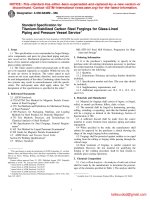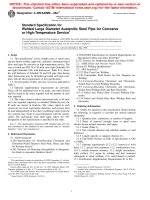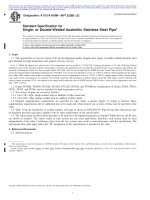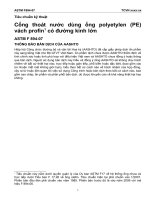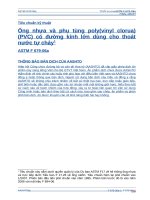Astm f 599 95
Bạn đang xem bản rút gọn của tài liệu. Xem và tải ngay bản đầy đủ của tài liệu tại đây (41.83 KB, 4 trang )
An American National Standard
Designation: F 599 – 95
Standard Specification for
Poly(Vinylidene Chloride) (PVDC) Plastic-Lined Ferrous
Metal Pipe and Fittings1
This standard is issued under the fixed designation F 599; the number immediately following the designation indicates the year of
original adoption or, in the case of revision, the year of last revision. A number in parentheses indicates the year of last reapproval. A
superscript epsilon (e) indicates an editorial change since the last revision or reapproval.
1. Scope
1.1 This specification covers factory-made poly(vinylidene
chloride) (PVDC) plastic-lined ferrous metal pipe and fittings
primarily intended for conveying corrosive liquids and gases.
Requirements for materials, workmanship, dimensions, construction, working pressure and temperatures, test methods,
and markings are included.
Forged or Rolled Alloy-Steel Pipe Flanges, Forged
Fittings, and Valves and Parts for High-Temperature
Service
Carbon-Steel Castings Suitable for Fusion Welding for
High-Temperature Service
Gray Iron Castings for Pressure-Containing Parts for
Temperatures up to 650°F (345°C)
Ferritic Ductile Iron Pressure-Retaining Castings for Use
At Elevated Temperatures
Ductile Iron Castings
NOTE 1—This specification does not include products coated with
PVDC nor does it define the suitability of PVDC-lined components in
chemical environments.
Title of Specification
Gray Iron Castings
Forgings, Carbon Steel for Piping Components
Gray Iron Castings for Valves, Flanges and Pipe Fittings
Forgings, Carbon Steel, for General Purpose Piping
Forged or Rolled Alloy-Steel Pipe Flanges, Forged
Fittings, and Valves and Parts for High-Temperature
Service
Carbon-Steel Castings Suitable for Fusion Welding for
High-Temperature Service
Piping Fittings of Wrought Carbon Steel and Alloy Steel for
Moderate and Elevated Temperatures
Gray Iron Castings for Pressure-Containing Parts for
Temperatures up to 650°F (345°C)
Alloy Steel Castings Specially Heat-Treated for PressureContaining Parts Suitable for High-Temperature Service
Ferritic Ductile Iron Pressure-Retaining Castings for Use at
Elevated Temperatures
Wrought Austenitic Stainless Steel Piping Fittings
NOTE 2—The PVDC sealing faces may prevent achievement of the full
pressure rating of the ferrous housing. For pressure limitations, the
manufacturer should be consulted.
1.3.1 For Ferrous Pipe:
ASTM
Designation
A 53
A 106
Gray Iron Castings
Forgings, Carbon Steel for Piping Components
Gray Iron Castings for Valves, Flanges, and Pipe Fittings
Forgings, Carbon Steel for General Purpose Piping
A 278
A 395
A 536
ASTM
Designation
A 48
A 105
A 126
A 181
A 182
A 216
A 234
A 278
A 389
A 395
A 403
1.4 The PVDC-lined pipe and fitting assemblies are limited
to use from −18 to 79°C (0 to 175°F). For use below −18°C
(0°F) consult the manufacturer. Use in specific aggressive
environments may alter the above temperature range. The
operating temperature range shall be established by mutual
agreement between consumer and producer.
A 513
A 135
A 587
1.3.2 For Ferrous Flanges:
Title of Specification
A 216
1.3.3 For Ferrous Fittings:
1.2 The values given in parentheses are provided for information purposes only.
1.3 The ferrous piping products shall meet the requirements
of the relevant specifications listed in 1.3.1, 1.3.2, and 1.3.3.
Nominal sizes from 1 through 8 in. in 125, 150, and 300 psi
ratings are covered.
Title of Specification
Pipe, Steel, Black, and Hot-Dipped, Zinc-Coated, Welded
and Seamless
Seamless Carbon Steel Pipe for High-Temperature
Service
Electric-Resistance-Welded-Carbon and Alloy Steel
Mechanical Tubing.
Electric-Resistance-Welded Steel Pipe
Electric-Welded Low-Carbon Steel Pipe for the Chemical
Industry
A 182
NOTE 3—Storage or handling below −7°C (20°F) of uninstalled 4, 6,
and 8-in. lined pipe should be avoided.
ASTM
Designation
A 48
A 105
A 126
A 181
2. Referenced Documents
2.1 ASTM Standards:
D 729 Specification for Vinylidene Chloride Molding Compounds2
D 792 Test Methods for Specific Gravity (Relative Density)
1
This specification is under the jurisdiction of ASTM Committee F-17 on Plastic
Piping Systems and is the direct responsibility of Subcommittee F17.11 on
Composite.
Current edition approved Sept. 10, 1995. Published November 1995. Originally
published as F 599 – 78. Last previous edition F 599 – 93.
2
Annual Book of ASTM Standards, Vol 08.01.
Copyright © ASTM International, 100 Barr Harbor Drive, PO Box C700, West Conshohocken, PA 19428-2959, United States.
1
F 599
and Density of Plastics by Displacement2
D 1505 Test Method for Density of Plastics by the DensityGradient Technique2
D 1600 Terminology for Abbreviated Terms Relating to
Plastics2
F 412 Terminology Relating to Plastic Piping Systems3
2.2 ANSI Standards:
B 16.1 Cast Iron Pipe Flanges and Flanged Fittings4
B 16.5 Steel Pipe Flanges and Flanged Fittings4
flange. Gaskets may also be required on fittings to provide
accommodation or elimination, or both, of sharp corners which
could damage the lining.
4.3.2 Material—Plain gaskets meeting the temperature requirements, or perforated metallic gaskets, may be used.
5. Requirements
5.1 Dimensions:
5.1.1 Housings—Housing installation dimensions are as
required in the applicable material specification listed in 1.3.
5.1.2 Wall Thickness—Fitting linings shall have a minimum
wall thickness of 3⁄32 in. (2.4 mm), and shall have a uniform
face thickness of not less than 3⁄32 in. Pipe linings shall have a
minimum wall thickness of 3⁄32in., and the flared radius and
gasket faces shall have a uniform thickness of not less than
80 % of the wall thickness. Molded faces shall not be less than
3⁄32 in. thick.
5.1.3 PVDC Face Diameter—The outside diameter of the
PVDC covering the gasket face of the flange or the full face of
the lap-joint stub end shall not be less than the diameter
specified in Table 1. They shall be concentric within 1⁄16 in. (1.6
mm).
5.1.4 Tolerances—Tolerance for pipe, flanges, and fittings
shall be as specified in Table 2. Bolt holes in both flanges on a
fixed spool shall straddle the same center line to facilitate
alignment. Finish lined (plastic face to plastic face) fabricated
fittings shall conform to the nominal face-to-face, etc., as
specified in ANSI B 16.1 or B 16.5 with the applicable
tolerances.
5.2 Flange Construction:
5.2.1 Screw-type flanges shall be secured in position to
prevent inadvertent turning of the flange.
5.2.2 Socket-type flange shall be fully back-welded to the
pipe housing and the inside surfaces of the socket flanges shall
be welded and ground smooth.
5.2.3 Slip-on flanges shall be fully back-welded.
3. Terminology
3.1 The terminology used is in accordance with Terminology F 412, and abbreviations are in accordance with Terminology D 1600, unless otherwise specified.
3.2 The abbreviation for poly(vinylidene chloride) is
PVDC.
4. Materials
4.1 Lining:
4.1.1 Material—The lining shall be made from PVDC
compounds conforming to the requirements of Specification
D 729, except that up to a 20 weight % glass fiber filler is used
to modify physical properties, and a maximum of 1 weight %
of colorant is permissible for identification. Organic colorants,
if used, shall be identified in the manufacturer’s specification.
4.1.2 The PVDC shall be virgin compound or clean reworked compound.
4.1.3 Mechanical Properties—The minimum tensile
strength and minimum elongation at yield when tested in
accordance with Specification D 729 shall be 1500 psi (10.34
MPa) and 2 % respectively. The minimum values for tensile
strength and elongation shall apply to both the longitudinal and
circumferential directions.
4.1.4 Specific Gravity—The linings manufactured from
PVDC resins with 20 % glass fibers shall have a relative
density of 1.8 to 1.9 when tested in accordance with the
requirements of Test Methods D 792 and D 1505.
4.2 Ferrous Pipe and Fittings:
4.2.1 Mechanical Properties—The mechanical properties of
the pipe and fittings shall conform to the requirements of the
appropriate specification of 1.3 except as they are influenced
by accepted methods of processing in the industry, for example, Van Stone flaring, bending, swaging, and welding. The
carbon steel pipe and wrought fittings shall be welded or
seamless steel, Schedule 40 or Schedule 80, except that
Schedule 30 pipe may be used in 8-in. nominal size.
4.2.2 Finish—The interior surfaces of all housings shall be
clean and free of mold burrs, rust, scale, or other protrusions
which may adversely affect integrity or performance of the
lining.
4.3 Back-Up Gaskets:
4.3.1 General—Back-up gaskets shall be used to cover the
pipe end and gasket face of threaded or slip-on flanges unless
a full radius or chamfer is provided at the end of the pipe and
NOTE 4—No welding shall be done on lined components.
5.2.4 Lap-joint (or Van Stone) flanged ends may be manufactured by standard forming techniques or by using fully
welded stub ends or collars. Lap-joints shall not contain any
cracks or buckles.
NOTE 5—The use of lap-joint flanges in a piping system may simplify
alignment.
5.3 Workmanship:
5.3.1 Pipe and fitting linings shall show no evidence of
pinholes, porosity, or cracks when inspected in accordance
with 5.4.2. The lining shall fit snugly inside the pipe and fitting
TABLE 1 PVDC Face Diameter
Nominal Pipe Size, in.
1
1.5
2
2.5
3
4
6
8
3
Annual Book of ASTM Standards, Vol 08.04.
Available from the American National Standards Institute, 11 West 42nd St.,
13th Floor, New York, NY 10036.
4
2
Minimum PVDC Face Diameter, in. (mm)
1
2
3
3
4
5
8
10
⁄
78
⁄
11 16
⁄
7 16
⁄
15 16
⁄
58
⁄
15 16
⁄
1 16
(47.62)
(68.26)
(87.31)
(104.01)
(117.48)
(150.81)
(203.20)
(255.59)
F 599
TABLE 2 Tolerances for Pipe, Flanges, and Fittings
air, hot and cold water, and drainage. Install the flanges using
the manufacturer’s recommended torque value. Pipe-spool
length shall be 10 ft (3 m) minimum. Mount the test specimens
in such a manner as to permit complete drainage and then
subject them to 100 hot water-cold water cycles, each of which
shall consist of the following in the sequence given:
6.2.2.1 Circulate 79 6 3°C (175 6 5°F) water through the
specimens until the ferrous housing skin temperature adjacent
to the flange at the outlet end of the test specimen has been
maintained at the maximum stabilized temperature for 30 min.
6.2.2.2 Close off hot water.
6.2.2.3 Drain and introduce air to purge the specimens for a
minimum of 1 min.
6.2.2.4 Circulate water at a maximum temperature of 25°C
(77°F). Circulate the cooling water until the ferrous housingskin temperature adjacent to the flange at the outlet end of the
test specimen measures 38°C (100°F) maximum.
6.2.2.5 Drain and introduce air to purge the specimens for a
minimum of 1 min, making certain that specimens are completely drained.
6.2.3 There shall be no evidence of leakage from the flanges
during the 100 cycles. At the completion of the test, the liner
shall show no evidence of buckling, cracking, or crazing.
6.2.4 At the conclusion of the testing specified in 6.2.2, the
lined pipe or fitting shall be subjected to the hydrostatic test
specified in 7.1, or, after drying, to the electrostatic test
specified in 7.2.
6.3 Vacuum Testing:
6.3.1 Test representative production samples of the PVDClined pipe and fittings to determine the vacuum ratings of the
lined components. Test a minimum of two pipe spools, tees,
and 90-deg elbows in each size. Conduct tests at room
temperature and at the manufacturer’s-maximum recommended service temperature.
Tolerance, in. (mm)
Pipe:
Length
Fixed flange bolt hole alignment
Flange perpendicularity (with pipe
centerline)
Flanges and Fittings:
All dimensions
6 1⁄8 (63)
6 1⁄16 (61.6)
3⁄32 in./ft (2.38 mm/m) of diameter
per ANSI B 16.1 or ANSI B 16.5
housings. Any bulges or other obvious indication of poor
contact with the housing shall be cause for rejection.
5.3.2 The gasket face portion of the PVDC linings shall be
free of surface defects that could impair sealing effectiveness.
Scratches, dents, nicks, or tool marks on the gasket surface
shall not be deeper than 10 % of the wall thickness.
5.4 Performance:
5.4.1 Qualification—PVDC-lined pipe and fittings must be
capable of meeting the requirements specified in Section 6.
5.4.2 Inspection:
5.4.2.1 Each lined pipe and fitting, prior to shipment, shall
be subjected to a hydrostatic test or an electrostatic test, or
both, as specified in 7.1 or 7.2. The test or tests to be used shall
be at the option of the manufacturer, unless otherwise specified
by the purchaser.
5.4.2.2 Each lined pipe and fitting shall subsequently be
visually inspected prior to shipment to verify conformance to
the design and dimensional requirements of 5.3.
5.4.2.3 Each lined pipe and fitting shall bear an inspection
verification impression stamp on the housing to indicate
compliance with the requirements of this specification.
6. Qualification Tests
6.1 Temperature Test:
6.1.1 Representative production samples of PVDC-lined
pipe and fittings shall be cycled in an oven from room
temperature to 79 6 3°C (175 6 5°F) to determine the ability
of the lined components to withstand heat aging and temperature cycling. A minimum of two pipe spools, tees, and 90-deg
elbows shall be tested in each size.
6.1.2 Install companion flanges at the manufacturer’s recommended torque value, and affix a thermocouple to the
ferrous housing to measure the temperature. Pipe spools shall
be at least 3-ft (0.9-m) long. After 3 h in an oven at 79°C
(175°F) as indicated by the thermocouple, air cool the lined
components to 29°C (85°F) maximum. Repeat this test for a
total of three cycles.
6.1.3 Inspect the PVDC-lined pipe and fittings after each
cycle for distortion or cracks in the lining. At the completion of
the third cycle, subject specimens to either the hydrostatic or
electrostatic test described in 7.1 or 7.2.
6.2 Thermo Cycling Test:
6.2.1 Subject representative production samples of PVDClined pipe and fittings to hot water-cold water cycling to
determine the ability of the lined components to withstand
rapid temperature changes. Test a minimum of two pipe spools,
tees, and 90-deg elbows in each size.
6.2.2 Assemble the PVDC-lined pipe and fittings with
suitable-blind flanges having provision for the introduction of
NOTE 6—Vacuum-temperature ratings should be published in the
manufacturer’s literature.
6.3.2 For pipe spools, specimen length shall be at least ten
pipe diameters. Install a flange incorporating a sight glass at
one end and a blind flange suitable for drawing a vacuum at the
other end. Make provisions for measuring the ferrous housing
temperature. Heat the specimens uniformly externally with the
sight-glass end visible, and after the specified ferrous housing
temperature is reached, begin the test. Hold a selected initial
vacuum level for 8 h, and if no failure occurs, increase the
vacuum by 2 in. Hg (6.8 kPa). Repeat every 8 h until full
vacuum is reached. Failure is defined as any buckling or
collapse of the liner. Full vacuum is defined as 29.6 in. Hg (100
kPa) corrected (a gage pressure of −100 kPa). If failure occurs
at the initial-vacuum level selected, test a new specimen at a
lower-vacuum level to determine the failure threshold. The
vacuum-failure threshold is defined as 1 in. Hg (3.4 kPa) below
that at which failure occurs.
NOTE 7—The external-pressure method to simulate higher than full
vacuum can be used to establish the failure threshold when full vacuum is
achievable. With the use of pressure taps, an external pressure is applied
between the liner outside diameter and the pipe inside diameter.
6.3.3 The vacuum rating shall be 80 % of the failure
threshold value.
3
F 599
electrical contact is made with the housing because of a defect
in the liner, shall be cause for rejection.
6.3.4 At the test (6.3.2) completion, and after the vacuum
rating (6.3.3) is established, heat a duplicate specimen to the
specified test temperature. Apply the rated vacuum to the
specimen after the specified-skin temperature has been
reached. Achieve the rated vacuum within 2 min, and apply
continuously for 48 h. If no liner buckling or collapse occurs,
the vacuum rating shall be considered acceptable.
6.4 Retest—When a test specimen fails to meet the requirements of 6.1, 6.2, or 6.3, the cause of failure shall be sought
and corrected. Repeat the temperature test specified in 6.1, the
hot water-cold water cycling test specified in 6.2, and the
vacuum test specified in 6.3, using double the number of test
specimens.
8. Marking
8.1 Marking on pipe and fittings shall include the following:
8.1.1 Nominal pipe size,
8.1.2 Liner material identification (PVDC),
8.1.3 Manufacturer’s name (or trademark),
8.1.4 This designation “ASTM F 599,”
8.1.5 Length (on pipe only), and
8.1.6 . Other information such as order numbers, part
numbers, item numbers, etc., at the purchaser’s request.
8.2 Pipe-liner identification shall be provided on a band
containing the raised letters “PVDC”. One band is required on
fittings and on pipe lengths up to 6 ft (2 m); two bands are
required for pipe lengths over 6 ft. The band will typically be
located near the flange.
7. Inspection Tests
7.1 Hydrostatic-Pressure Test—The internal test pressure
shall be 250 psi (1720 kPa) minimum for 125-psi (862-kPa)
components and 425 psi (2930 kPa) for 150-psi and 300-psi
components. Conduct the test at ambient temperature. Completely fill the pipe and fitting with clean water and bleed the
system free of all air prior to application of pressure. Reach full
test pressure within 1 min and maintain for a further 3 min.
Observe the pressure gage and test specimen, throughout the
test for any evidence of leakage which shall be cause for
rejection.
7.2 Electrostatic Test—Conduct the test with a nondestructive high-voltage tester at an output voltage of 10 kV. A visible
or audible spark, or both, that occurs at the probe when
9. Packaging
9.1 The gasket face of each lined pipe and fitting shall be
protected by end plates or other suitable protective means, such
as individual boxing.
10. Quality Assurance
10.1 When the product is marked with this designation,
F 599, the manufacturer affirms that the product was manufactured, inspected, sampled, and tested in accordance with this
specification and has been found to meet the requirements of
this specification.
The American Society for Testing and Materials takes no position respecting the validity of any patent rights asserted in connection
with any item mentioned in this standard. Users of this standard are expressly advised that determination of the validity of any such
patent rights, and the risk of infringement of such rights, are entirely their own responsibility.
This standard is subject to revision at any time by the responsible technical committee and must be reviewed every five years and
if not revised, either reapproved or withdrawn. Your comments are invited either for revision of this standard or for additional standards
and should be addressed to ASTM Headquarters. Your comments will receive careful consideration at a meeting of the responsible
technical committee, which you may attend. If you feel that your comments have not received a fair hearing you should make your
views known to the ASTM Committee on Standards, 100 Barr Harbor Drive, West Conshohocken, PA 19428.
4



